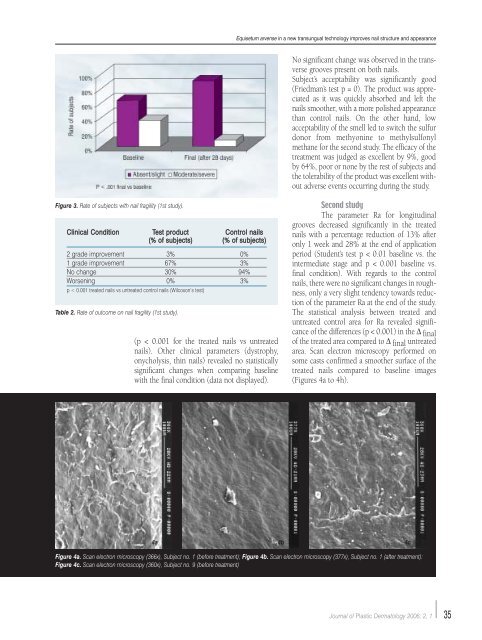Aprile Vol.2 N° 1 - 2006 - Salute per tutti
Aprile Vol.2 N° 1 - 2006 - Salute per tutti
Aprile Vol.2 N° 1 - 2006 - Salute per tutti
Create successful ePaper yourself
Turn your PDF publications into a flip-book with our unique Google optimized e-Paper software.
Figure 3. Rate of subjects with nail fragility (1st study).<br />
Clinical Condition Test product Control nails<br />
(% of subjects) (% of subjects)<br />
2 grade improvement 3% 0%<br />
1 grade improvement 67% 3%<br />
No change 30% 94%<br />
Worsening 0% 3%<br />
p < 0.001 treated nails vs untreated control nails (Wilcoxon’s test)<br />
Table 2. Rate of outcome on nail fragility (1st study).<br />
(p < 0.001 for the treated nails vs untreated<br />
nails). Other clinical parameters (dystrophy,<br />
onycholysis, thin nails) revealed no statistically<br />
significant changes when comparing baseline<br />
with the final condition (data not displayed).<br />
4a<br />
Equisetum arvense in a new transungual technology improves nail structure and appearance<br />
No significant change was observed in the transverse<br />
grooves present on both nails.<br />
Subject’s acceptability was significantly good<br />
(Friedman’s test p = 0). The product was appreciated<br />
as it was quickly absorbed and left the<br />
nails smoother, with a more polished appearance<br />
than control nails. On the other hand, low<br />
acceptability of the smell led to switch the sulfur<br />
donor from methyonine to methylsulfonyl<br />
methane for the second study. The efficacy of the<br />
treatment was judged as excellent by 9%, good<br />
by 64%, poor or none by the rest of subjects and<br />
the tolerability of the product was excellent without<br />
adverse events occurring during the study.<br />
Second study<br />
The parameter Ra for longitudinal<br />
grooves decreased significantly in the treated<br />
nails with a <strong>per</strong>centage reduction of 13% after<br />
only 1 week and 28% at the end of application<br />
<strong>per</strong>iod (Student’s test p < 0.01 baseline vs. the<br />
intermediate stage and p < 0.001 baseline vs.<br />
final condition). With regards to the control<br />
nails, there were no significant changes in roughness,<br />
only a very slight tendency towards reduction<br />
of the parameter Ra at the end of the study.<br />
The statistical analysis between treated and<br />
untreated control area for Ra revealed significance<br />
of the differences (p < 0.001) in the ∆ final<br />
of the treated area compared to ∆ final untreated<br />
area. Scan electron microscopy <strong>per</strong>formed on<br />
some casts confirmed a smoother surface of the<br />
treated nails compared to baseline images<br />
(Figures 4a to 4h).<br />
4b 4c<br />
Figure 4a. Scan electron microscopy (366x), Subject no. 1 (before treatment); Figure 4b. Scan electron microscopy (377x), Subject no. 1 (after treatment):<br />
Figure 4c. Scan electron microscopy (360x), Subject no. 9 (before treatment)<br />
Journal of Plastic Dermatology <strong>2006</strong>; 2, 1 35

















